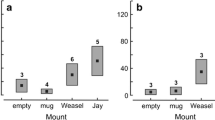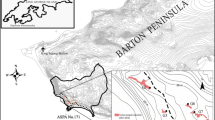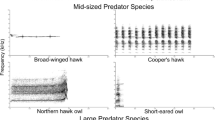Abstract
We assessed the ability of southern house wrens (Troglodytes aedon musculus) to recognize and discriminate different birds of prey. We exposed nesting birds to stuffed specimens of two sympatric predator species, the chimango caracara (Milvago chimango, a nest predator) and the roadside hawk (Buteo magnirostris, a predator of adults and nests), and to a dummy of a non-sympatric predator, the double-toothed kite (Harpagus bidentatus, a predator of adults). Nesting wrens avoided going into their nest or took a longer time to resume their parental duties when exposed to the predators than when they were exposed to a control dummy (Chrysomus ruficapillus, a sympatric blackbird). Nest avoidance was higher when birds were exposed to the roadside hawk but no differences were detected when exposed to the chimango caracara or the double-toothed kite. The results indicate that southern house wrens are able to recognize a predator, responding in a graded manner. Our findings support the hypothesis that southern house wrens exhibit a threat-sensitive response during breeding. Also, individuals were able to recognize the unknown predator but failed to correctly assess the threat level represented by it. We propose that correct assessment of threat level by house wrens requires direct experience with the predator, which might mediate in the modulation of the response.




Similar content being viewed by others
References
Baker AJ, Whitacre DE (1999) Observation of a double-toothed kite (Harpagus bidentatus) hawking bats. J Raptor Res 33:343–344
Barret HC (2005) Adaptations to predators and prey. In: Buss DM (ed) The handbook of evolutionary psychology. Wiley, New York, pp 200–223
Bates D, Maechler M, Bolker B, Walker S (2015) Fitting linear mixed-effects models using lme4. J Stat Soft 67:1–48
Belton W, Dunning JS (1982) Aves silvestres do Rio Grande do Sul, vol 6. Fund Zoobot Rio Grande do Sul
Beránková J, Veselý P, Sýkorová J, Fuchs R (2014) The role of key features in predator recognition by untrained birds. Anim Cogn 17:963–971
Beránková J, Veselý P, Fuchs R (2015) The role of body size in predator recognition by untrained birds. Behav Proccess 120:128–134
Brightsmith D (2002) What eats parrots? What are the major predators on parrots in the wild? Bird talk mag. http://vetmed.tamu.edu/macawproject/publications/magazine-articles. Accessed 24 July 2017
Brown LH, Amadon D (1968) Eagles, hawks and falcons of the world. McGraw-Hill, New York
Buitron D (1983) Variability in the responses of black-billed magpies to natural predators. Behaviour 87:209–235
Carlson NV, Healy SD, Templeton CN (2017a) A comparative study of how British tits encode predator threat in their mobbing calls. Anim Behav 125:77–92
Carlson NV, Healy SD, Templeton CN (2017b) Hoo are you? Tits do not respond to novel predators as threats. Anim Behav 128:79–84
Caro T (2005) Antipredator defenses in birds and mammals. University of Chicago Press, Chicago
Carro ME, Mermoz ME, Fernández GJ (2014) Factors affecting the probability of double brooding by southern house wrens. J Field Ornithol 85:227–236
Chivers DP, Ferrari MCO (2013) Tadpole antipredator responses change over time: what is the role of learning and generalization? Behav Ecol 24:1114–1121
Chivers D, Mirza R (2001) Predator diet cues and the assessment of predation risk by aquatic vertebrates: a review and prospectus. In: Marchlewska-Koj A, Lepri J, Müller-Schwarze D (eds) Chemical signals in vertebrates 9. Springer, USA, pp 277–284
Chivers DP, Smith RJF (1998) Chemical alarm signalling in aquatic predator-prey systems: a review and prospectus. Écoscience 5:338–352
Corral MG, Carro ME, Fernández GJ (2012) Alarm calls of nesting southern house wrens (Troglodytes musculus). Ornitol Neotrop 23:251–260
Csermely D, Casagrande S, Calimero A (2006) Differential defensive response of common kestrels against a known or unknown predator. Ital J Zool 73:125–128
Curio E (1975) The functional organization of anti-predator behaviour in the pied flycatcher: a study of avian visual perception. Anim Behav 23:1–115
Curio E (1976) The ethology of predation. Springer, Berlin
Curio E (1993) Proximate and developmental aspects of antipredator behavior. Adv Study Behav 22:135–238
Curio E, Klump G, Regelmann K (1983) An anti-predator response in the great tit (Parus major): is it tuned to predator risk? Oecologia 60:83–88
Dale S, Gustavsen R, Slagsvold T (1996) Risk taking during parental care: a test of three hypotheses applied to the pied flycatcher. Behav Ecol Sociobiol 39:31–42
Di Giacomo AG (2005) Aves de la Reserva El Bagual. In: Di Giacomo AG, Krapovickas SF (eds) Historia natural y paisaje de la Reserva El Bagual, provincia de Formosa, Argentina. Inventario de la fauna de vertebrados y de la flora vascular de un área del Chaco Húmedo. Temas de Naturaleza y Conservación 4. Aves Argentinas/AOP, Buenos Aires, pp 203–465
Dickey DR, Van Rossem AJ (1938) The birds of El Salvador. Field Museum Natural History Zoological Series, vol 23. Chicago, Illinois, USA
Donázar JA, Travaini A, Rodríguez A, Ceballos O, Hiraldo F (1996) Nesting association of raptors and buff-necked ibis in the argentinean Patagonia. Colon Waterbird 19:111–115
Edelaar P, Wright J (2006) Potential prey make excellent ornithologists: adaptive, flexible responses towards avian predation threat by Arabian Babblers Turdoides squamiceps living at a migratory hotspot. Ibis 148:664–671
Fasanella M, Fernández GJ (2009) Alarm calls of the southern house wren Troglodytes musculus: variation with nesting stage and predator model. J Ornithol 150:853–863
Fernández GJ, Llambías PE (2013) Parental risk-taking behaviour and nest defence during the nestling rearing stage in northern house wrens Troglodytes aedon. Acta Ornithol 48:55–63
Fernández GJ, Corral MG, Carro ME (2012) Variation in the alarm calls of southern house wrens (Troglodytes musculus). Emu 112:71–75
Fernández GJ, Corral MG, Llambías PE (2015) Sexual differences in risk-taking behaviour of the southern house wren during the nestling rearing stage. Acta Ethol 18:11–18
Ferrari MCO (2009) Threat-sensitive learning and generalization of predator recognition by aquatic vertebrates. PhD Thesis. University of Saskatchewan
Ferrari MCO, Gonzalo A, Messier F, Chivers DP (2007) Generalization of learned predator recognition: an experimental test and framework for future studies. Proc R Soc Lond B 274:1853–1859
Ferrari MCO, Messier F, Chivers DP, Messier O (2008) Can prey exhibit threat-sensitive generalization of predator recognition? Extending the predator recognition continuum hypothesis. Proc R Soc Lond B 275:1811–1816
Fraga R, Salvador S (1986) Biología reproductiva del chimango (Polyborus chimango). Hornero 12:223–229
Göth A (2001) Innate predator-recognition in Australian brush-turkey (Alectura lathami, Megapodiidae) hatchlings. Behaviour 138:117–136
Griffin AS, Evans CS, Blumstein DT (2001) Learning specificity in acquired predator recognition. Anim Behav 62:577–589
Groom MJ (1992) Sand-colored Nighthawks parasitize the anti-predator behavior of three nesting bird species. Ecology 73:785–793
Helfman GS (1989) Threat-sensitive predator avoidance in damselfish-trumpetfish interaction. Behav Ecol Sociobiol 24:47–58
Helfman G, Winkelman DL (1997) Threat sensitivity in bicolor damselfish: effects of sociality and body size. Ethology 103:369–383
Hirsch SM, Bolles RC (1980) On the ability of prey to recognize predators. Z Tierpsychol 54:71–84
Hobson KA, Bouchart ML, Sealy SG (1988) Responses of naive yellow warblers to a novel nest predator. Anim Behav 36:1823–1830
Hothorn T, Bretz F, Westfall P (2008) Simultaneous inference in general parametric models. Biom J 50:346–363
Howell TR (1972) Birds of the lowland pine savanna of northeastern Nicaragua. Condor 74:316–340
Johnson FR, McNaughton EJ, Shelley CD, Blumstein DT (2003) Mechanisms of heterospecific recognition in avian mobbing calls. Austr J Zool 51:577–585
Królikowska N, Szymkowiak J, Laidlaw RA, Kuczyński L (2016) Threat-sensitive anti-predator defence in precocial wader, the northern lapwing Vanellus vanellus. Acta Ethol 19:163–171
Kullberg C, Lind J (2002) An experimental study of predator recognition in great tit fledglings. Ethology 108:429–441
Liljesthröm M, Fasola L, Valenzuela A, Raya Rey A, Schiavini A (2014) Nest predators of flightless steamer-ducks (Tachyeres pteneres) and flying steamer-ducks (Tachyeres patachonicus). Waterbirds 37:210–214
Lima SL (1998) Stress and decision making under the risk of predation: recent developments from behavioural, reproductive, and ecological perspectives. Adv Study Behav 27:215–290
Lima SL, Dill LM (1990) Behavioral decisions made under the risk of predation: a review and prospectus. Can J Zool 68:619–640
Llambías PE, Fernández GJ (2009) Effects of nestboxes on the breeding biology of southern house wrens Troglodytes aedon bonariae in the southern temperate zone. Ibis 151:113–121
Llambías PE, LaBarbera K, Astié AA (2012) Similar patterns of parental provisioning in a monogamous and a polygynous population of the House Wren. Condor 114:629–638
Llambías PE, Carro ME, Fernández GJ (2015) Latitudinal differences in life-history traits and parental care in northern and southern temperate zone house wrens. J Ornithol 156:933–942
MacLean SA, Bonter DN (2013) The sound of danger: threat sensitivity to predator vocalizations, alarm calls, and novelty in gulls. PLoS ONE 8:e82384
Marzluff JM, DeLap JH, Haycock K (2015) Population variation in mobbing ospreys (Pandion haliaetus) by American crows (Corvus brachyrhynchos). Wilson J Ornithol 127:266–270
McLean IG, Rhodes G (1991) Enemy recognition and response in birds. Curr Ornithol 8:173–211
Mezquida ET, Marone L (2003) Are results of artificial nest experiments a valid indicator of success of natural nests? Wilson Bull 115:270–276
Mitchell MD, Chivers DP, McCormick MI, Ferrari MCO (2015) Learning to distinguish between predators and non-predators: understanding the critical role of diet cues and predator odours in generalisation. Sci Rep 5:13918
Němec M, Syrová M, Dokoupilová L, Veselý P, Šmilauer P, Landová E, Lišková S, Fuchs R (2015) Surface texture and priming play important roles in predator recognition by the red-backed shrike in field experiments. Anim Cogn 18:259–268
Owings DH, Coss RG (1977) Snake mobbing by California ground squirrels: adaptive variation and ontogeny. Behaviour 62:50–68
Palleroni A, Hauser M, Marler P (2005) Do responses of galliform birds vary adaptively with predator size? Anim Cogn 8:200–210
Panasci T (2013) Roadside Hawk. In: Jenny JP (ed) Neotropical birds of prey: biology and ecology of a forest raptor community (Whitacre DF). Cornell University Press, Ithaca, pp 152–163
Panasci T, Whitacre D (2000) Diet and foraging behavior of nesting roadside hawks in Petén, Guatemala. Wilson Bull 112:555–558
Salvador SA (2016) Registros de depredadores de huevos, pichones y volantones de aves de Argentina. Acta Zool Lill 60:136–147
Schulze MD, Córdova JL, Seavy NE, Whitacre DF (2000) Behavior, diet, and breeding biology of double-toothed kites at a Guatemalan lowland site. Condor 102:113–126
Schulze MD, Córdova JL, Seavy NE, Whitacre DF (2013) Double-toothed kite. In: Jenny JP, Whitacre DF (eds) Neotropical birds of prey: Biology and ecology of a forest raptor community. Cornell University Press, Ithaca, pp 68–81
Serra C, Fernández GJ (2011) Reduction of nestlings’ activity in response to parental alarm calls in the Southern house wren, Troglodytes musculus. J Ornithol 152:331–336
Shalter MD (1978) Mobbing in the pied flycatcher. Effect of experiencing a live owl on responses to a stuffed facsimile. Ethology 47:173–179
Shalter MD (1984) Predator-prey behavior and habituation. In: Petrinovich PL (ed) Habituation, sensitization, and behavior (Harman VS). Academic, New York, pp 349–391
Shettleworth SJ (2010) Cognition, Evolution, and Behavior, 2nd edn. Oxford University Press, New York
Sih A (1987) Prey refuges and predator-prey stability. Theor Pop Biol 31:1–12
Skutch AF (1953) Life history of the southern house wren. Condor 55:121–149
Stankowich T, Coss RG (2007) The re-emergence of felid camouflage with the decay of predator recognition in deer under relaxed selection. Proc R Soc London B 274:175–182
Strnad M, Němec M, Veselý P, Fuchs R (2012) Red-backed shrikes (Lanius collurio) adjust the mobbing intensity, but not mobbing frequency, by assessing the potential threat to themselves from different predators. Ornis Fenn 89:206–215
Suzuki TN (2012) Referential mobbing calls elicit different predator-searching behaviours in Japanese great tits. Anim Behav 84:53–57
R Core Team (2016) R: A language and environment for statistical computing. R Foundation for Statistical Computing, Vienna, Austria. http://www.R-project.org/. Accessed 24 July 2017
Templeton CN, Greene E, Davis K (2005) Allometry of alarm calls: black-capped chickadees encode information about predator size. Science 308:1934–1937
Therneau T (2015) Mixed effects Cox models. https://cran.r-project.org/web/packages/coxme/vignettes/coxme.pdf. Accessed 24 July 2017
Tobar C, Rau J, Santibáñez A, Arriagada A, Sade S, Araneda R, Tello F (2015) Dieta del tiuque (Milvago chimango) en agroecosistemas de la ciudad de Osorno, sur de Chile. Bol Chil Ornitol 20:13–16
Turney S, Godin J-GJ (2014) To forage or hide? Threat-sensitive foraging behaviour in wild, non-reproductive passerine birds. Curr Zool 60:719–728
Tvardíková K, Fuchs R (2012) Tits recognize the potential dangers of predators and harmless birds in feeder experiments. J Ethol 30:157–165
Veen T, Richardson DS, Blaakmeer K, Komdeur J (2000) Experimental evidence for innate predator recognition in the Seychelles warbler. Proc R Soc London B 267:2253–2258
Vergara PM (2007) Effects of nest box size on the nesting and renesting pattern of Aphrastura spinicauda and Troglodytes aedon. Ecol Austral 17:133–141
Veselý P, Buršíková M, Fuchs R (2016) Birds at the winter feeder do not recognize an artificially coloured predator. Ethology 122:937–944
Webb PWJ (1982) Avoidance responses of fathead minnow to strikes by four teleost predators. Comp Physiol 147:371–378
Yáñez J, Núñez H (1980) Análisis de información y similitud para dos formas de determinación del espectro trófico en Milvago chimango (Vieillot). Bol Mus Nac Hist Nat (Chile) 37:113–116
Young CG (1929) A contribution to the ornithology of the coastland of British Guiana. Part II. Ibis 71:1–38
Young BE (1994) Geographic and seasonal patterns of clutch-size variation in house wrens. Auk 111:545–555
Acknowledgements
We thank Mariana E. Carro, Paulo E. Llambías, and Myriam E. Mermoz for help in the field, the Whisky-Michellis family and Luis García for allowing us to work on their ranches in Buenos Aires, and Mario Beade for logistical support. We thank V. Ferretti and two anonymous reviewers for their comments on an earlier version of this manuscript. Also, we thank V. Ferretti for checking the English grammar. This manuscript has been proofread by the Proof-Reading-Service.com, Devonshire (UK). This work was supported by grants to G.J.F. provided by the University of Buenos Aires (UBACyT 20020090200117) and CONICET (PIP112-200901-00011).
Author information
Authors and Affiliations
Corresponding author
Ethics declarations
Ethical Approval
All methods used in the present study meet the ethical requirements for science research and comply with the current laws of the country in which they were performed.
Conflict of Interest
The authors declare that they have no conflicts of interest.
About this article
Cite this article
Duré Ruiz, N.M., Fasanella, M. & Fernández, G.J. Breeding southern house wrens exhibit a threat-sensitive response when exposed to different predator models. J Ethol 36, 43–53 (2018). https://doi.org/10.1007/s10164-017-0528-6
Received:
Accepted:
Published:
Issue Date:
DOI: https://doi.org/10.1007/s10164-017-0528-6




